
By Scott Larson
Agricultural rescues and extrications are high-risk/low-frequency events. Many fire departments do not spend time training for these responses. With an official workplace fatality rate of more than 21 per 100,000, farming is the most dangerous occupation in America. Departments need to train for these specialized emergencies. This article covers two of the many possible agricultural emergencies to which a department may be called.
Tractor Rollover
You must consider special factors when responding to a farm setting and must be familiar with the machinery involved. Tractors are constructed of materials that are stronger than those you are accustomed to finding in a vehicle extrication. Shutting off an unfamiliar piece of machinery can also be a challenge. In a tractor rollover, the difficulty in shutting off the engine can be compounded if a victim is trapped against or near the controls.
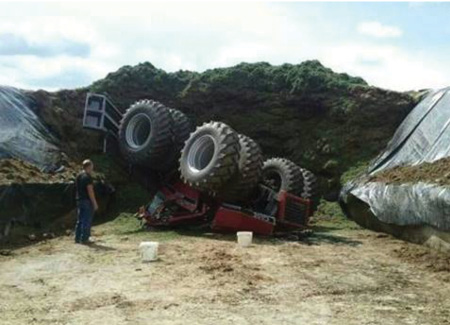 |
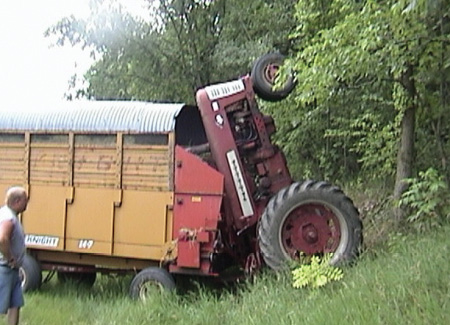 |
(1) Scene safety and proper stabilization are musts. (Photos courtesy of Stateline Farm Rescue unless otherwise noted.) (2) This position presents a unique stabilization challenge. (Photo by author.)
The method used to shut off the engine depends on the type of engine. A tractor may continue to run even while overturned. Shutting off a gasoline engine may be as simple as turning a key. However, the key can be bypassed for a multitude of reasons and may not work. If the key is not available or is nonfunctional, pulling the coil wire while discharging a carbon dioxide (CO2) extinguisher will stall the engine and mitigate sparks. In a diesel engine, the fuel shutoff control is typically a pull knob that may be difficult to locate and easy to overlook. The industry standard color for a fuel shutoff is orange, although a missing knob may be replaced with any color or style available. In the latest tractors, the control panels look more appropriate for a video game than for a farm implement. The best way to familiarize yourself with a variety of farm equipment is to visit a local farm implement dealership and ask a mechanic about the various shut-down procedures and alternatives.
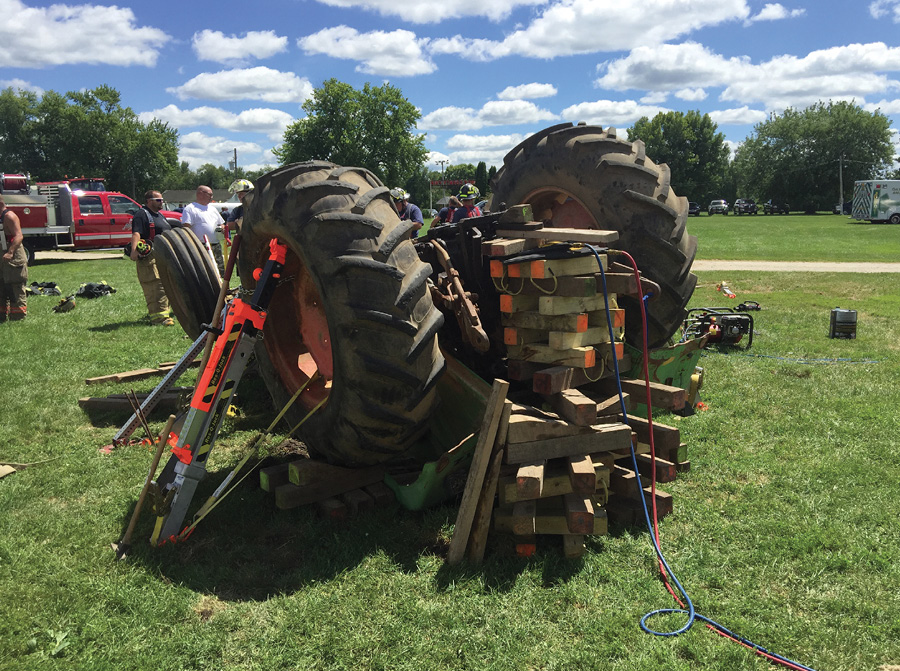
(3) This upside-down tractor has been stabilized.
Stabilization
The stability of a tractor in any position during extrication will test a department’s stabilization ability. Understanding the fundamentals of cribbing is crucial to the safety of the victims and responders. Proper stabilization can ensure safety while effectively securing the tractor.
The center of gravity of an upside-down tractor allows for a safe approach at the front or rear of the tractor (photo 1). If on an incline (photo 2), the placement of apparatus or other farm equipment may provide an anchor for attaching a winch, a come-along, or chains to the uphill side of the tractor, which may help prevent the implement from sliding farther downhill.
For a tractor on its top (photo 3), begin stabilization by placing step cribbing on the sides of the tractor from the front position, if safely accessible. Struts must be placed from the ground to the frame. Ensure that the struts are long enough to allow lifting room; this will prevent the need to reset the struts later.
A tractor rolled onto its side is in the most unstable position (photo 4), since it has only two points of contact with the ground. Thus, approach the tractor with extreme caution. Again, a proper stabilization process can ensure safety while effectively securing the tractor. As when the tractor is on its top, the safe zones are still at the front and rear. Strut placement on a tractor on its side is critical; place a minimum of four, two on each side of the tractor, and secure properly. On some occasions, up to six to eight struts may be needed.
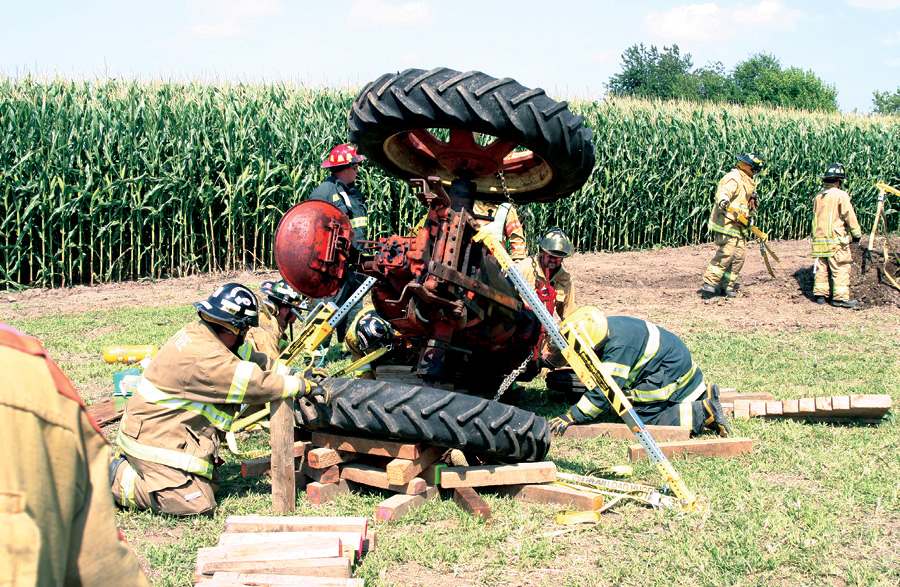
(4) This tractor had to be stabilized on its side.
Box cribbing placed at the opposite end of the tractor will create a fulcrum for lifting operations (photo 4). During a front-end lift, the cribbing should support the drawbar if it is in good condition. Cribbing under the rear axle is acceptable as well. Typically, a tractor frame will extend beyond the grille of the tractor. If this substructure exists, a box crib built to support the tractor here would be ideal in a rear-lift situation. Build the box cribbing at the end being lifted as the tractor is raised. The rule of thumb, as with any extrication, is to lift an inch, crib an inch. Remember, as the lift is being performed, struts need to be monitored and readjusted. Step cribbing can be advanced from both sides as the lift occurs; this will take up any void spots that may occur. Assign personnel to each stabilization point during the lift to ensure the cribbing and the struts remain in place and secure.
The position of the tractor, the victim, and the terrain will determine the lifting point. Lifting as close to the victim as safely as possible will create the greatest amount of travel with the least amount of lift. With proper stabilization, you can lift using air bags, a high-lift jack, or a hydraulic spreader. Use caution when placing your lifting apparatus. If lifting from the tractor tire, lift from the rim. Do not lift on the rubber part of the tire; this may cause a rupture, possibly releasing fluid in the tire. If placing the air bags under the tractor’s hood, fill the void between the engine and the hood with cribbing to ensure part of the lift isn’t wasted on crushing the hood.
Grain Engulfment
A grain engulfment rescue will test the limits of your resources. Use a practical and an organized approach. The proper number of personnel will ensure the response will be successful without compromising responder safety. Large numbers of responders are needed to successfully perform all the operations at these scenes. Mutual aid, technical rescue teams, advanced medical care, and law enforcement are just a few resources you may need.
OSHA Standards
A variety of bin structures are used in industry. The Occupational Safety and Health Administration (OSHA) has issued two types of standards covering entry into these structures. Grain Handling Facilities Standard (29CFR 1910.272) applies to grain-storage structures such as bins and silos and applies to the following: feed mills, flour mills, rice mills, dust pelletizing plants, dry corn mills, soybean flaking, grain elevators, and dry grinding of soy cake. This standard is known as a “vertical” regulation, meaning it was written to apply to a specific industry.
Permit Required Confined Space Standard (29CFR 1910.146) applies to the following structures: pits (boot, dump, and so on), tanks (fuel, mineral oil, and so on), vessels, hoppers, and vaults. This regulation was intended to apply to any type of work in which employees enter permit-required confined spaces. This is considered a “horizontal standard”—in other words, it applies to all industry types. Knowing the differences in these standards and the type of structure you may be entering will help you to determine which regulation to follow.
RELATED: Grain Bin Rescue | Rural Connections: The Importance of Training | Grain Bins: A Complex Response Requiring a Complex Solution | From The Ground Up
Understanding the types of bin construction will aid you in formulating a plan of action when you arrive on the scene. The crews who will make cuts in the bin must be able to identify the type of bin construction to ensure efficiency and safety while cutting.
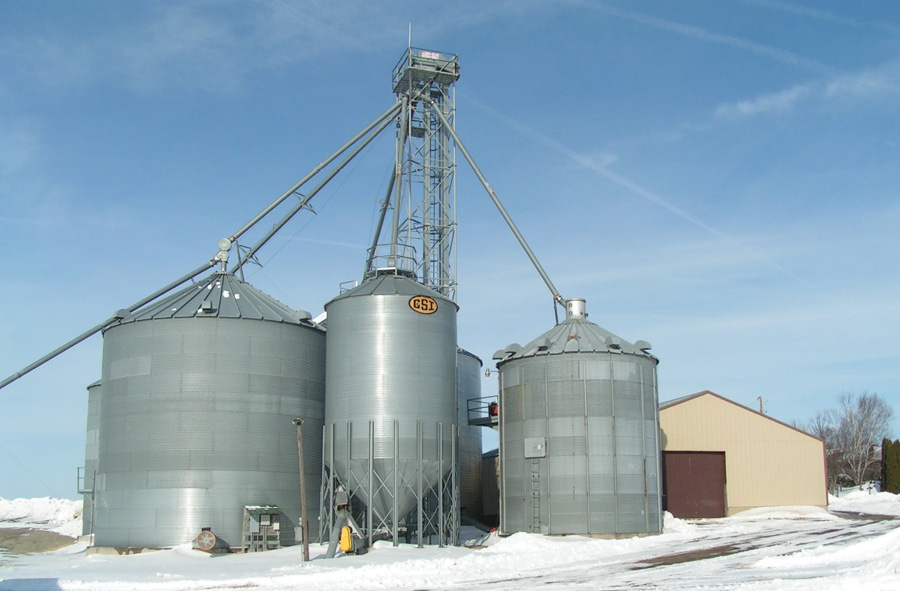
(5) Grain storage.
On Scene
A primary concern when arriving on scene is to locate the primary power source for the facility. Turn it off and use all lock-out/tag-out procedures associated with the bin, including the augers that help move the grain. Check with someone familiar with the facility to ensure that all sources of power, including the backup generator, have been neutralized.
Test and monitor the air within the bin for the presence of combustible and toxic gases and to determine if there is sufficient oxygen. Calibrate the monitors outside of the bin in a fresh-air environment. Begin by testing the air from outside of the structure, working slowly down to the victim. When testing, sample in several levels because of the possibility of the stratification of gases. Entrants should wear a personal air-monitoring device. Perform and document air monitoring at regular intervals throughout the rescue effort. Use proper ventilation to improve air quality.

(6) Lock out/tag out the power supply.
Each entrant must also be on a lifeline before entering the bin. The use of proper rescue rope and approved harnesses is critical. Grain bin ladders and other similar structures are commonly of lightweight metal construction. Do not use them as anchor points for life safety rope.
Rescue Operation
If the entrapped victim is partially visible, determine his level of consciousness. If conscious, reassure the victim. Throw a rope to the victim and ask him to tie it under his arms. If possible, lower a dust mask and a bottle of water to help him hydrate; you can attempt to lower oxygen to the victim to assist with his respiration. Try to determine if the victim entered the bin alone. Ask if he is aware of his body position in relation to the surface of the grain. One of his legs or arms may be extended (photo 8).
Several commercial coffer dams (rescue tubes) are on the market. They have a groove on one side of the panel and an opposing piece fitting that groove on the opposite side. Some slide through a channel running from the top to the bottom of the panel. Others butt against one another and clamp together. Be sure the channel is free of debris to ensure a relatively tight fit. Place the tube around the victim one panel at a time, being careful not to hit him. If the victim is conscious, have him fold his arms across his chest to ensure he doesn’t get hit by one of the panels. If the victim is unconscious, a rescuer will need to support him throughout the rescue.
Continue to remove grain from inside the tube and advance the tube farther into the grain until the victim can get free (photo 9). The conscious victim can assist with the removal of grain from the tube. If the victim is young and healthy, has not been exposed to the elements, and has not struggled for an extended period, he may be able to free himself in knee-deep grain. If the victim is cold, overheated, or fatigued, you may have to continue digging to the victim’s ankles. Once you have freed the victim from the grain, package him and remove him from the bin. Flowing grain from the sides of the bin will help you to locate the victim. Unload the bin evenly. Most grain bins are not designed to be loaded heavily on one side, and unloading grain from only one side may compromise the bin’s structural integrity.
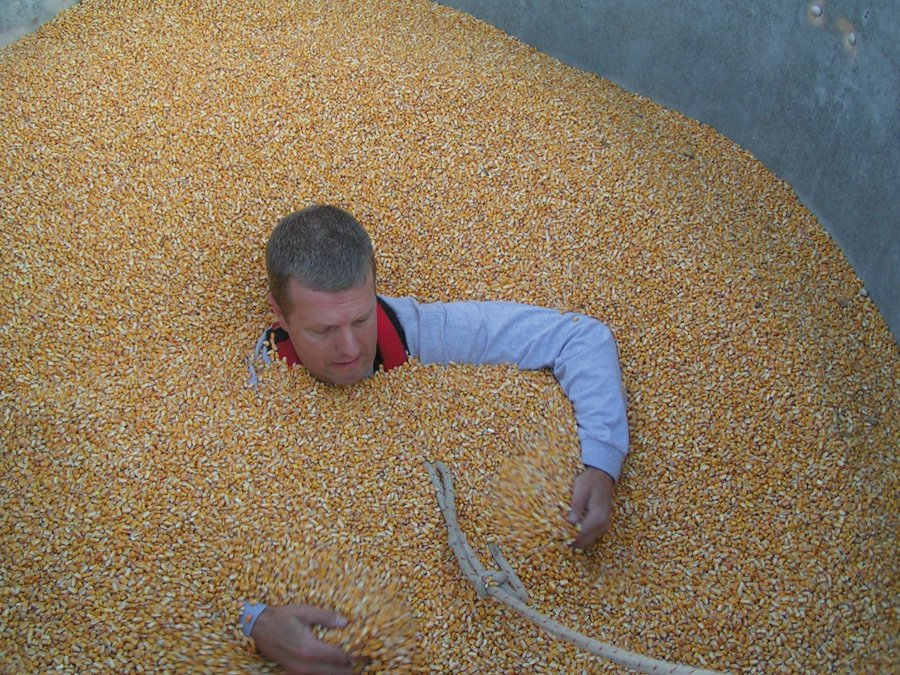
(7) A visible entrapped victim.
You can cut into the bin with several types of tools. Make each cut below the product line; do not disturb the bolt patterns. Cutting below the product line negates the dust-to-air ratio needed to create a dust explosion. Have a charged line or fire extinguisher at each cutting location. Have a spotter at the top hatch of the bin during the unloading operation to halt the process once the victim is visible. Make cuts in a “V” shape with the point down. This will maintain the integrity of the bin sheet being cut. Bend up the flap to allow the grain to flow and reposition it to control the flow of grain should the need arise. Stop the flow by bending the flap back into place; hold it in place with a cribbing wedge or bar. With thicker bin sheets, it may be necessary to use a hydraulic spreader to open the flap created by the “V” cut.
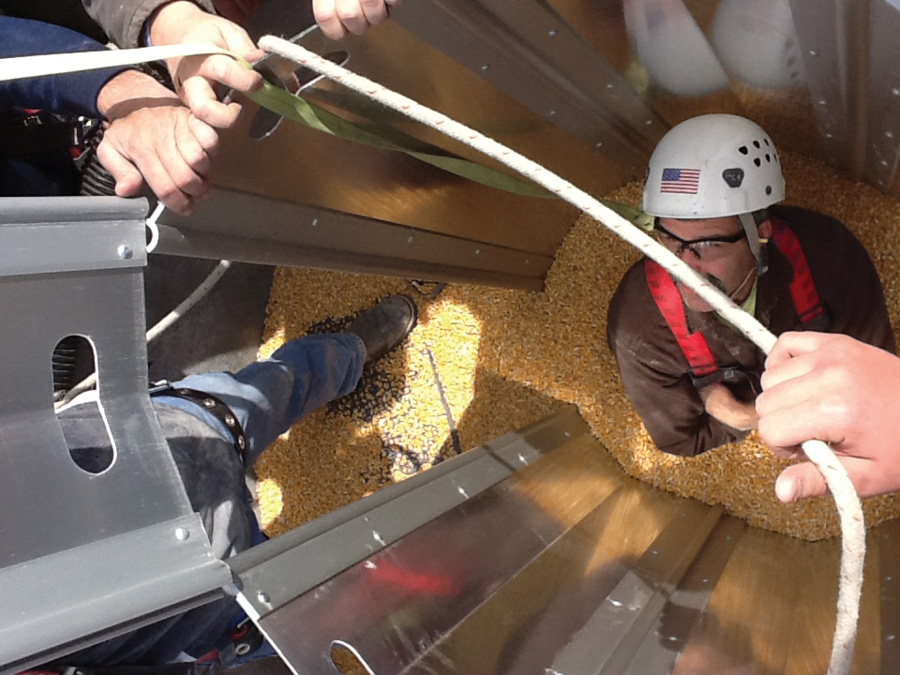

(8) The rescue tube. (9) Flowing grain. (Photo by author.)
Preplanning
Have your department members tour local grain facilities in your jurisdiction in preparation for creating a preplan. Understanding the types of bins and products on site, where and how to lock out/tag out the power, and even the best areas for staging equipment will be most beneficial should your department be called to rescue someone from a grain bin. Proper training and preplanning will help to increase the victim’s chance for survival, create a safer rescuer environment, and prevent chaos during what is a prolonged and exhausting extrication.
These examples represent only two of the many emergencies that can occur in a rural or an agricultural environment. Power take off and auger entanglement, combine entrapment, manure pit, chemical and hazardous materials response, and animal incidents are additional farm-related scenarios for which fire departments should seek active training. Work with area farmers, equipment dealers, or salvage yards to gain access to equipment and props to aid in training for these emergencies.
Scott Larson is a 32-year fire service veteran and a lieutenant with the Madison (WI) Fire Department. He is certified as an emergency medical technician, firefighter II, fire instructor II, and hazmat specialist. He is trained to the technician level in collapse, trench, high angle, and confined space rescue. He is an instructor with Stateline Farm Rescue, which provides rural and farm emergency training in the upper Midwest.

